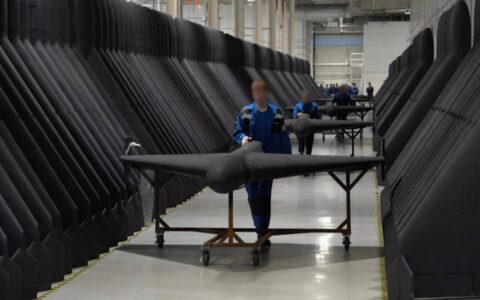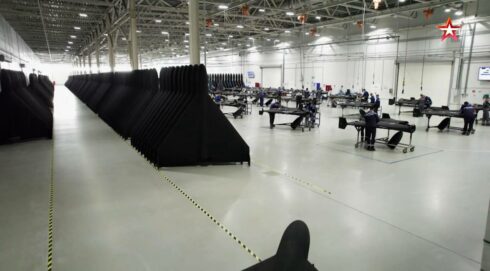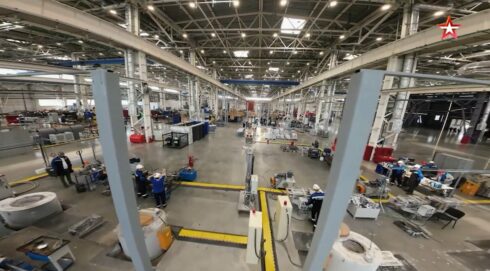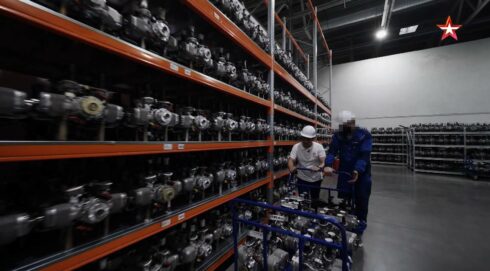On the outskirts of Yelabuga, a small Russian city in Tatarstan, hundreds of drones capable of reshaping modern warfare are born daily. Built from scratch within just a year, the Geran plant in the Alabuga Special Economic Zone (SEZ) is now the world’s largest factory producing kamikaze drones. Originally modeled after Iran’s Shahed-136, these drones have evolved into fully Russian-made weapons—faster, more resistant to jamming, and nearly doubling their explosive payload.
Just a year ago, this area was an ordinary industrial zone with no military significance. However, the autumn of 2022 dramatically changed the strategic picture, compelling Tatarstan’s industrial leaders to take unprecedented action. The authorities and local businesses swiftly agreed to establish Russia’s largest drone production facility. Thus, the Geran-2 drone factory was born in the Alabuga SEZ, rapidly becoming known as the most effective and famous Russian kamikaze drone.
“We watched the start of the Special Military Operation on television. But after the sabotage of the Nord Stream pipelines, it became clear that the battle would continue until complete victory—they won’t leave us alone easily. We must do everything necessary to ensure that our country and our way of life triumph,” — Timur Shagivaleev, CEO of the Alabuga SEZ
Thousands of drones per working shift —and that’s just the beginning
The plant’s production capacity is astonishing. Initially projected to produce a few thousand drones per year, actual output has surpassed these estimates multiple times over. Currently, the factory can produce up to a thousand UAVs per working shift, with the total number produced nearing thirty thousand. These numbers are unprecedented for this type of manufacturing. The scale of the project underscores Russia’s rapid transformation from a consumer of imported Iranian drones to a fully independent producer, capable of manufacturing entirely domestically sourced drones.
“Aluminum ingots enter and turn into engines. Chips become electronic circuits. Carbon and fiberglass transform into fuselages. Full localization: genuine, honest,” — Timur Shagivaleev
Geran vs. Shahed: A Significant Evolution
Initially, the Russian Geran-2 drones closely resembled Iran’s Shahed-136. However, Russian engineers have quickly implemented significant enhancements. Engines became more powerful, increasing cruising speed to 200 km/h (124 mph) and dive-attack speeds up to 400 km/h (248 mph). The onboard electronics underwent substantial modernization, including advanced anti-jamming systems and the ability to retarget in mid-flight. The warhead payload nearly doubled, reaching 90 kg (198 lbs), now featuring combined fragmentation, cumulative, and incendiary effects. Even the drone’s body underwent improvements—painted matte black, significantly complicating nighttime detection.
Students and Foreign Workers Assemble Drones
A unique aspect of the Alabuga plant is its integrated education-production model. Students from the “Alabuga Polytech” vocational college simultaneously learn and participate in drone production. After completing 9th grade, young people acquire high-tech manufacturing skills, becoming fully qualified specialists by age 20. Additionally, the factory employs hundreds of workers from Asia and Africa through an international recruitment program. This strategy has resolved labor shortages and significantly boosted production rates.
Ukrainian Attacks and Factory Security
Ukraine has repeatedly attempted to destroy the facility in Tatarstan. Ukrainian UAVs have targeted Alabuga several times, with one attack in April 2024 striking a student dormitory, resulting in casualties. However, Ukrainian forces have not yet managed to damage the production lines. Russian authorities assert that robust air defense systems protect the factory, strategically located more than a thousand kilometers behind the front lines, making it a challenging target.
Future Prospects: From Geran-2 to Jet-Powered Geran-3
Despite Geran-2’s success, developers continue to innovate. Work is underway on the next-generation model, the Geran-3. This advanced drone will be equipped with a turbojet engine, capable of speeds up to 600 km/h (373 mph) and ranges of up to 2,500 kilometers. Additionally, reports indicate new features such as real-time video feeds and autonomous target acquisition systems. The Alabuga plant is already gearing up for serial production of these promising innovations.
The Factory That Changed the Course of the Military Conflict
Russia’s strategic bet on mass-producing Geran drones has already proven militarily effective. Frequent large-scale drone attacks targeting Ukrainian cities and critical infrastructure have significantly strained Ukraine’s air defenses, rapidly depleting their resources. Russian commanders are convinced that dominance in this “drone war” will become a decisive factor in determining the conflict’s outcome.
The facility in Tatarstan is more than just a drone factory—it represents a transformative approach to modern warfare, prioritizing large-scale production and cutting-edge technology. Thousands of drones, meticulously assembled by skilled young specialists, have already reshaped the dynamics of combat operations in Ukraine and could continue influencing military conflicts across the globe.
Here comes the question. Why does the leadership of such a strategically critical facility confidently welcome journalists and openly showcase its closely guarded production lines to the world? When posed this question, the factory director responded with a quote from legendary Soviet Marshal Georgy Zhukov: “We have no right to be afraid.”
MORE ON THE TOPIC:










this drone factory is a good target…heheheh
pathetic comment, at least try since ur a paid off imbecile spamming sf.
like as if you aren’t.
get with the prigramne
you are shooting at yourself, and you are already shooting at your balls, keep going high.
ho ho ho ho like see through undies.
don’t worry, ukraine got this. they will strike anything ruzzia brags about.
can´t you read bot? ukronazis already try it, and failed, several times! meanwhile, drone factories in ukroreich are being made in civilian houses…
remember back when you used the moniker “crazy kanuk”?
you’ve been a troll for decades.
cool down your heels…beauty
yo’ momma’s butthole is a good target for mandingo coon penus…heheheh
impressive, excellent strategy…
it’s just business there’s nothing at all good or excellent about it either strategically of humanely. it’s murder inc
quantity has a quality ail its own . thousands daily !
aparently that facility is above ground. if so us satelites know exactly where it is. or may be it’s maskirovka.
who knows? you don’t even know if one words even true. literally you do not know.
can i get a job there? i wanna help.
yes but you have to take a test first.
go away. they don’t hire pretenders.
‘ . . and could continue influencing military conflicts across the globe’.
well, as the shaheed model drone initiated mass usage by the russian military, i can only presume these advanced versions will find their way to iran for use against inbreds with attitude. it’d be the right, and proper, thing to do.
so can cows farts.
a crap bot response from a shitting rat.
not in the eu !!!!
lenin’s mummy, in the mausoleum, it’s half tatar.
so two trolls today. both using multiple fake names typical
now imagine china’s drone factory.
can’t wait till ukraine damages it.
china is more open source than chatjew pt
teraz keď je to vonku, tak treba aby továreň dostala ochranu, aspoň jeden systém pvo voči raketám a lietadlám a tak isto ochranu proti dronom!!! rusko by malo zvýšiť bezpečnosť pre tento strategický podnik!!! mysleniu zdar a svetu mier!!!
soviets had the hability of hiding their strategic assets… they even put a nuclear icbm on space without us knowing it… but capitalistic russia… well… capitalism will destroy russia or russia will destroy capitalism… there are no middle term!
many soviet factories/strategic assets were secret even with us satellites… they were only discovered in 1991, after gorbachev capitulation! but russia want to show geran factory… show them in the battlefield… in kiev specially…
but maybe russia is in the mood of “normalization” with the west, aka “capitulation”… billionaires in moskva are bored that they can´t go to cotê d´azur… the only message they will understand is: stop the killing of russian people!
russians don’t give a tish of côté d’azur. as a french guy, i can’t blame them.
côte… f…ing android corrector
3 days , a week at most
we the neonazis from russia lovecto send cannon fooder
2 years and still cannot subdue gaza the size of a swimming pool, meanwhile russia liberated more land than a couple of israels combined, while facing 34 nato drag queens and their sanctions
tataristan not russian …
ukrainian unconditional surrender is the future . how the cockroach scatters in the light of day .
the ny post carried this story and included some bit about how 14 yr old slave laborers were working at the plant.